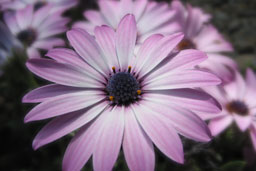 |
 |
 |
 |
 |
 |
 |
 |
 |
 |
 |
 |
 |
 |
 |
 |
 |
 |
 |
 |
 |
 |
 |
 |
 |
 |
 |
 |
 |
 |
 |
 |
 |
 |
 |
 |
 |
 |
 |
 |
 |
 |
 |
 |
|
 |
|
 |
|
|
 |
|
|
|
|
|
|
 |
|
 |
|
|
|
 |
|
 |
|
 |
|
 |
|
|
|
|
|
|
Namasté or Namaskar ( in Hindi, from Sanskrit namaste; Pronounced Nah-mah-stay) is a South Asian greeting originating in India, which is used when both hello and goodbye would be used in English. The meaning is quite different, however Sanskrit nama? means bow, obeisance, reverential salutation, adoration. Te is the dative of the personal pronoun tvam. A literal translation of nama? te is thus reverential salutation to you. It is commonly accompanied by a slight bow made with the hands pressed together, palms touching, in front of the chest; In a religious context this word can be taken to mean any of these:
*The Spirit in me meets the same Spirit in you. * I greet that place where you and I are one. *I salute the Light of God in you. * I bow to the divine in you.; * I recognize that within each of us is a place where Divinity dwells, and when we are in that place, we are One. *My higher energy salutes your higher energy; In other words, it recognizes the equality of all, and pays honor to the sacredness and interconnection of all, as well as to the source of that interconnection. Namaskar is the term for such greetings, and is also used as a greeting itself. |
|
|
|
 |
|
|
|
 |
|
| Religious practices of various faiths are an integral part of everyday life in Indian society. Religion in India is a very public affair, with many practices imbued with pomp and vitality accompanying their underlying spiritual qualities. Education is highly regarded by members of every socio-economic stratum. Traditional Indian family values are highly respected, and considered sacred, although urban families have grown to prefer a nuclear family system, owing to the socio-economic constraints imposed by the traditional joint family system. |
|
|
|
|
|
|
|
|
|
 |
|
|
|
 |
|
|
|
|
|
 |
|
|
|
In India, people learn the essential themes of cultural life within the bosom of a family. In most of the country, the basic units of society are the patrilineal family unit and wider kinship groupings. The most widely desired residential unit is the joint family, ideally consisting of three or four patrilineally related generations, all living under one roof, working, eating, worshiping, and cooperating together in mutually beneficial social and economic activities.
Patrilineal Indian joint families include men related through the male line, along with their wives and children. Most young women expect to live with their husband's relatives after marriage, but they retain important bonds with their natal families. Despite the continuous and growing impact of urbanization, secularization, and Westernization, the traditional joint household, both in ideal and in practice, remains the primary social force in the lives of most Indians. Loyalty to family is a deeply held ideal for almost everyone. |
|
|
|
|
|
 |
|
|
Indians prostrate before their parents, elders, teachers and noble souls by touching their feet. The elder in Indian culture in return blesses us by placing his or her hand on or over our heads. Prostration is done daily, when we meet elders and particularly on important occasions like the beginning of a new task, birthdays, festivals etc. In certain traditional circles, prostration is accompanied by abhivaadana, which serves to introduce one-self, announce one's family and social stature. Man stands on his feet. Touching the feet in prostration is a sign of respect for the age, maturity, nobility and divinity that our elders personify. It symbolizes our recognition of their selfless love for us and the sacrifices they have done for our welfare. It is a way of humbly acknowledging the greatness of another.
This tradition reflects the strong family ties, which has been one of India's enduring strengths. The good wishes (Sankalpa) and blessings (aashirvaada) of elders are highly valued in India. We prostrate to seek them. Good thoughts create positive vibrations. Good wishes springing from a heart full of love, divinity and nobility have a tremendous strength. When we prostrate with humility and respect, we invoke the good wishes and blessings of elders, which flow in the form of positive energy to envelop us. This is why the posture assumed whether it is in the standing or prone position, enables the entire body to receive the energy thus received. |
|
|
|
 |
|
|
|
Free Moving Quote |
|
|
To - My BLOG to share whats on your body and mind |
|
|
|
|
|
|
 |
|
|
 |
|
|
|
|
|
 |
|
|
|
|
|
|
|
Search the Web with Google |
|
|
|
|










